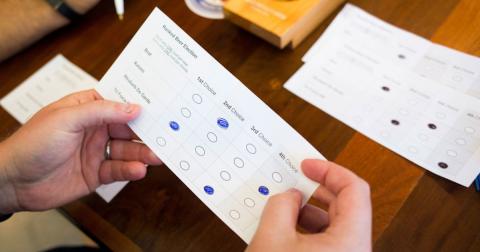5 million New Yorkers are set to vote on the measure, which if passed, voters will be able to rank up to 5 candidates in primary and special elections for Mayor, Public Advocate, Comptroller, Borough President, and City Council beginning in January 2021.
Critics say there are many pros to a ranked choice voting system rather than a “first-past-the-post” or “winner takes all” system, where voters simply indicate the candidate of their choice and the candidate who receives the most votes wins.
Some of the benefits of RCV include:
- Promotes majority support. By only advancing a candidate that has more than half the vote. If there is not a candidate with more than half the vote, the candidate in last place will be eliminated and the voters who ranked the last place candidate as their first choice will have their votes allocated to their second choice. This continues until one of the remaining candidates has more than half the vote.
- Provides more options for voters. By eliminating the concern of vote splitting. When many similar candidates are running for a party’s primary, the major candidate in the race may have votes taken away by a minor candidate. For example, if candidate A1 receives 30% of the votes, similar candidate A2 receives another 30% of the votes, and dissimilar candidate B receives the remaining 40% of the votes, plurality voting declares candidate B as the winner, even though 60% of the voters prefer either candidate A1 or A2.
- Saves taxpayers money. By removing the need for unnecessary and expensive runoff elections.
- Minimizes strategic voting. By lessening the sentiment that voters have to choose the “lesser of two evils” and gives voters the opportunity to rank candidates honestly without worrying about what other voters are doing.
Closed Primary Conundrum
An important point that’s going uncovered in the media is the fact that the Big Apple has a closed primary system for all elections. This means that people may only vote in a party’s primary election if they are registered members of that party prior to election day. If RCV passes, registered Democrats will rank Democratic candidates and registered Republicans will rank Republican candidates. Primary elections often see significantly lower turnout but are a crucial part of the election as they determine which final candidates will move on to the general election.
While New York City’s measure for Top-5 Ranked Choice Voting has some capabilities for producing more independent-minded party candidates, the measure fails to open up competition to third parties and independents. There is nothing written in the measure for ranking all candidates regardless of party affiliation or for those who do not want to be registered with a party. In the end, this means that nonpartisan voters have absolutely no say in which candidates advance to the general election.
Some reform advocates argue that despite the city’s closed primary, using Ranked Choice Voting even if just for the closed primary, helps move the needle in the right direction. Mainstream news organizations such as the New York Times and the Guardian have been reporting on the story with nuanced opinions that further elevate the conversation and bring up the question of extending RCV into the presidential primaries and general election as Maine has recently done.
Other reform advocates may argue that RCV in a closed primary system does little to increase political competition outside of the two parties, where it is needed most. Candidates of the two major parties will still be campaigning to their general bases, with the comforting thought that at the end of a long day at the polls, it will still be registered party members deciding their fates.
It does raise the question: Will RCV really make a significant difference in how New York City politicians campaign if they still only have to appeal to voters of just their particular party?
Stay tuned.
